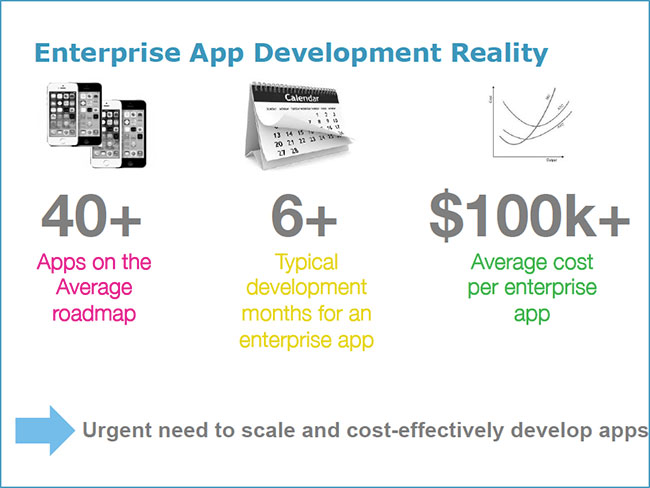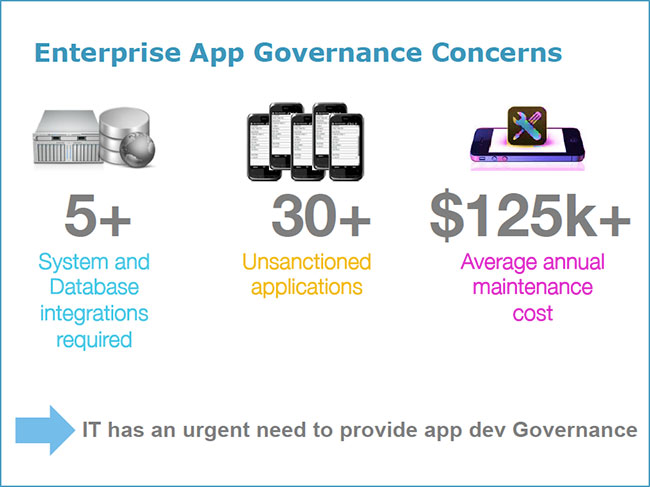Digital transformation requires that IT organizations rapidly evolve to support the needs of a real time enterprise. According to a recent survey conducted on MobileEnterpriseStrategies.com, 78% of companies said their mobile strategies are inhibited by IT and 84% said their IT systems were too slow or incapable of supporting their real time mobile initiatives1. Clearly there is a gap between what is required to be successful and the reality of the obstacles IT is facing in the enterprise.
How can enterprises fulfill their needs for mobility? How can IT keep control while letting business users get secure data access and build apps? Let’s take a closer look at what’s happening within enterprise application development:
The Rise of “My Experience App” in Enterprise
Trends in mobile device usage by consumers are often replicated within the enterprise.
Over the last year, we’ve seen a migration in the way customers interact. It used to be vendors could make apps just for their own products and services but that’s not good enough anymore. Customers want apps built for THEM, not the vendor. We are starting to see this sort of hyper-personalization in enterprise. It might be around specific workflows, roles in the company, location or geography. Much like consumer facing apps, enterprise apps today need to be real time, personalized, and always on. In addition to those things, apps have exploded in popularity, with individual business units demanding their own specific applications, which has led to skyrocketing costs.
The Reality of Enterprise App Development

On average, companies have 40+ apps on their roadmap, everything from tracking retail store traffic to employee directories to sales enablement and collaboration. The time it normally takes IT to develop these kinds of applications is somewhere around 6 months and it can cost more than $100,000 per app.
Governance Concerns

Due to the urgent need to scale and build apps, the number of ‘rogue’ apps can spread like wildfire across enterprises. Different business units need different apps and will go to great lengths to get what they need, often times consulting with outside development shops to build them. It may not seem like a big deal, but these rogue apps can have serious implications to the business, including security risks, as they are often times connected to cloud services without IT knowing. It’s this lack of governance that keeps IT up at night. But should IT be tasked with building all the apps across the enterprise in order to keep these issues at bay? What role should IT have in app development so that they stay relevant and so that organizations can execute effectively on their mobility roadmaps and digital transformations?
Improving the App Building Process
At AnyPresence we believe ITs role should be empowering stakeholders at all levels across the enterprise: from field/business users to business IT users to the mobile app development teams. IT should play more of a governance gatekeeper role, if you will, where their focus is more on identifying the apps that are no code that business users could be developing themselves, the set of the low code apps that need minimal technological know-how and the custom code or high touch apps.

Conclusion
AnyPresence’s App LaunchPad can be used to empower different audiences within an enterprise and keep IT relevant and in charge of governance. With App LaunchPad, IT can get full access to the code, which allows flexibility for any UI tool (ie: Xamarin) and flexibility for deployment. And non-developers can build apps themselves using checklists and forms and easily sync with Oracle and SQL databases.
If you’re interested in learning more about how App LaunchPad can help IT govern the app development process, drop us a note. Or check out the presentation from our webinar last week, “Mobility and the Real-Time Enterprise.”
1The Real-Time Mobile Infrastructure Survey was conducted on www.MobileEnterpriseStrategies.com and included 80 IT and business professionals from across the world.